Many modern users of computers and mobile devices can no longer imagine life without the Internet, which is firmly established in our everyday life. Relatively recently, new cloud technologies have appeared, which are quite different from the classical models of computer systems, although at some points they work on similar principles. However, for many, the very concept of a "cloud", although familiar, is still incomprehensible. Read on for what it is.
What is cloud technology?
If we talk about the concept in simple terms, we can say that technological solutions of this type basically imply the storage and use of information, software or special services without actually using hard drives on computers (they are used only for the initial installation of client software with purpose of access to cloud services).
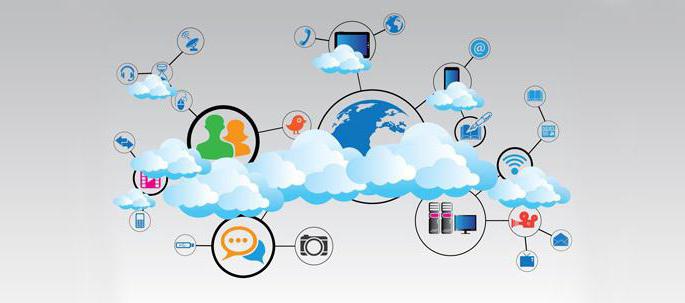
In other words, the use of cloud technology allows you to use only the purely computing resources of a computer terminal or mobile device. Such an explanation to many may seem too confusing. Therefore, in order to understand how the application of cloud technologies in practice looks, one can give the simplest example.

Most modern users, one way or another, use e-mail. Often it is the presence of such an address that is necessary for registration in Internet services, social networks, online games, etc. In any Windows system, there is a built-in Outlook mail client. When you receive or send letters, all of them are saved directly on the hard drive in the program folder.
Another thing is when the mailbox is located on a remote server (for example, Mail.Ru, Gmail, Yandex-mail, etc.). The user simply logs on to the site, enters his registration data (username and password), and then gets access to his mail. This is cloud technology in the simplest sense, since all correspondence is stored not on a user computer (hard disk), but on a remote server. Actually, a special program for accessing the mailbox is not needed (the usual web browser, which in this case acts as a client application, is enough).
Thus, the most important thing that distinguishes cloud technologies from standard IT methods consists precisely in saving information or some kind of software on a remote server, which at one time was called the “cloud”, and in the possibility of sharing data or BY. Today, you can see many services that are built specifically on the principles of the cloud. But it was not always so.
Cloud technology
In general, talk about the introduction of such models has been going on since the late 60s of the last century. Then came the concept of using the computing power of computer systems around the world with an organization in the form of public utilities, sponsored by Joseph Liklider and John McCarthy.

The next step was the introduction in 1999 of the so-called CRM systems in the form of subscription websites that provided access to computing resources via the Internet, which in 2002 began to actively use the Amazon online bookstore, which later transformed into a huge IT a corporation.
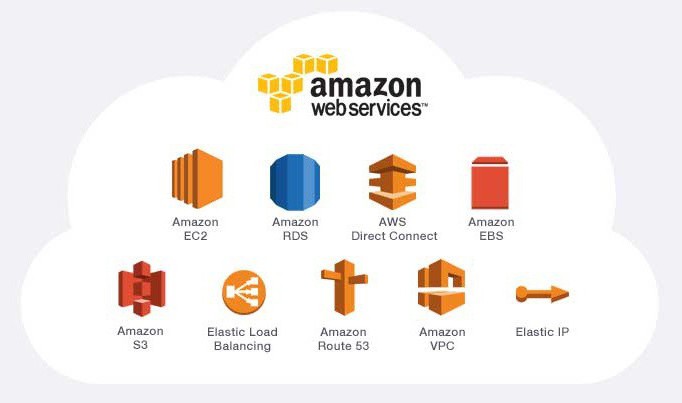
And only in 2006, thanks to the appearance of the Elastic Compute Cloud project, they started talking seriously about the full-scale implementation of cloud technologies and services. Naturally, the launch of the familiar Google Apps service, which took place in 2009, also played an important role in the provision of computing resources.
Modern cloud services
Since then, the cloud technology market has undergone quite serious changes. And the provision of computing resources alone was not limited.
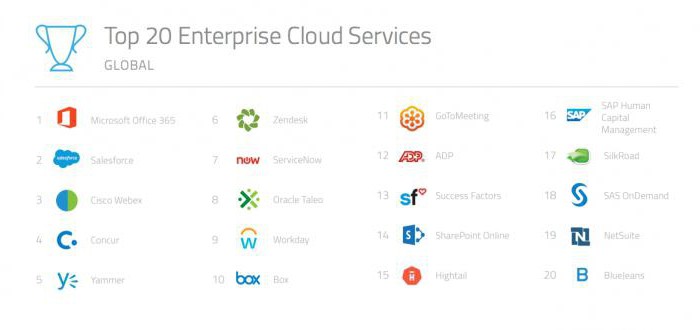
New cloud technologies and services began to appear, which today can conditionally be divided into several large categories:
- cloud information storages;
- game portals;
- antivirus platforms;
- web-based software tools.
Each of these groups includes many subcategories, but in general terms, they are all built on the same principles.
Mandatory Features
According to the generally accepted requirements of the US National Institute of Standards and Technology, there is a single list of conditions that cloud information technologies must meet:
- independent user service on demand (the ability of the user to determine the degree of use of technological and computing resources in the form of speed of access to data, server processing time, storage volume, etc., without mandatory coordination or interaction with a service provider);
- access to a network of a universal level (access to data transmission, regardless of the type of device used);
- consolidation of computing resources (dynamic redistribution of capacities by combining resources for a large number of users into a single pool);
- elasticity (the ability at any time to provide, expand or narrow the range of services automatically and at no additional cost);
- accounting for services provided to consumers (abstracting the traffic used, the number of users and the transactions they make, throughput, etc.).
Common classification of deployment models
Speaking about cloud technologies, one cannot but mention their separation by types of cloud service models used.
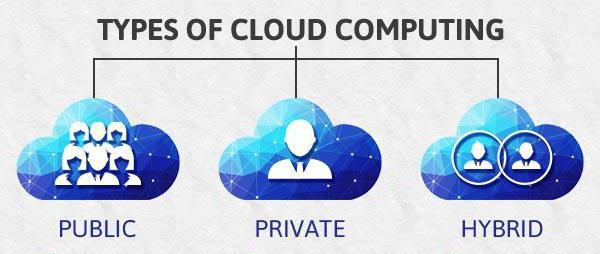
Among them there are several main groups:
- A private cloud is a separate infrastructure used by only one organization or enterprise, including several users, or by partner companies (contractors), which may belong to the organization itself or may be outside its jurisdiction.
- Public cloud is a structure intended for use by the general public in the public domain and, as a rule, is managed by the owner (service provider).
- A public cloud is an organizational structure designed for groups of users who have common interests or tasks.
- A hybrid cloud is a combination of two or more of the above types, which in the structure remain unique independent objects, but are interconnected according to strictly defined standardized rules for transferring data or using applications.
Types of Service Models
Separately, it is necessary to highlight the methodology for classifying service models, that is, the whole set of tools and tools that a cloud service can provide to a user.
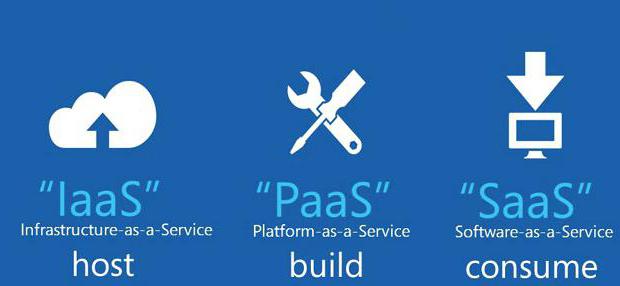
Among the main models, the following are distinguished:
- SaaS (software as a service) is a model of a set of software provided by a cloud provider to a consumer that can be used either directly in the cloud service from some device, either through access through thin clients, or through the interface of a special application.
- PaaS (platform as a service) is a structure that allows the user, on the basis of the provided tools, to use the cloud to develop or create basic software for the subsequent placement of other software (proprietary, acquired or replicated) based on database management systems, runtimes of programming languages, and Software, etc .;
- IaaS (infrastructure as a service) is a model of using a cloud service with independent resource management and the ability to host any type of software (even an OS), but with limited control of some network services (DNS, firewall, etc.).
Cloud Services Blocks
Since cloud technologies require minimal user participation in the entire complex and are models consisting of many technological combinations that interact with each other through the use of middleware, at this stage of the consideration of such services, we can separately identify some important components of any hardware and software complex that are accepted call blocks:
- Self-service portal is a tool that allows the user to order a certain type of service with the specification of additional details (for example, for IssA it is a virtual machine order with specification of the processor type, amount of RAM and hard disk or refusal to use it).
- Service catalog - a set of basic services and related templates for creating, which through the transfer of automation will be able to configure the created service in real-life computer systems and with a certain type of software.
- An orchestra is a specialized tool for monitoring the actions of performed operations, provided by the template for each service.
- Billing and billing - accounting for the services provided to the user, billing for payment to coordinate financial issues.
Additional methods
Among other things, sometimes for the purpose of load balancing, virtualization technology can be applied in the form of a virtual server part, which is a kind of layer or bundle between software services and hardware (distribution of virtual servers to real ones). This approach is not necessary, however, cloud technologies in education use this technique quite often.
Antiviruses look quite interesting too, which download suspicious files not to computers, but to the cloud or sandbox (Sandbox), where preliminary checks are performed, after which permission is given to send it to the computer, or it is quarantined in the the cloud.
Pros and cons of using cloud services
As for the pros and cons, they certainly are. The positive aspect is that when you access the software, storage, or create your own infrastructure for users of such services, the costs associated with acquiring additional or more powerful equipment or licensed software are significantly reduced.
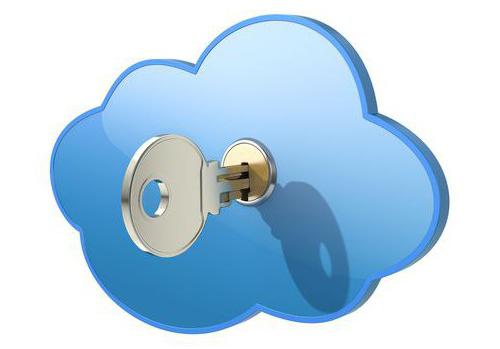
On the other hand, most experts criticize the use of cloud services only because of their low security against outside interference. The issue of storing huge volumes of outdated or unused data is also on the agenda. A striking example of this are Google services, in which the user cannot delete any data groups or unused services.
Payment Issues
Naturally, the use of such services is paid, especially if it is cloud-based technologies in education (specialized libraries, educational platforms), access to specialized software or regular data storages with large reserved volumes of disk space.
But for the average user, the same storage services like DropBox, OneDrive (formerly SkyDrive), Mail.Ru Cloud, Yandex.Disk and many others make concessions, allocating about 15-20 GB, depending on the service itself disk space without payment. By modern standards, of course, a little, but enough to save some important data.
Conclusion
That's it for cloud technology. Many experts and analysts promise them a great future, but the question of information security or data confidentiality is so acute that without the use of new developments in the field of information protection, such a bright prospect looks very doubtful.